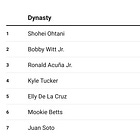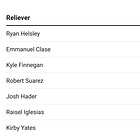Fantasy Baseball 2025 Redraft Top 500 Rankings & Trade Value Version 2.13
Two underrated fantasy starters, a slugger enjoying a strong start to 2025 and a catcher to keep an eye on in deeper leagues.
This week: a potentially underrated starting pitcher who has a very real shot at finishing the year as a top 25 (or better) fantasy starter.
Plus, a slugger hitting the cover off the ball at the plate, an underrated fantasy catcher from the same team (a catcher who’s due to see his numbers bounce back at the plate), plus an emerging young starter in the midst of a breakout campaign.
All that and more after this week’s top 500.
(A quick note, if you’re having trouble reading the table in full in the Substack app, it can be viewed in full either in the email or in a web browser.)
If you have any questions about trade offers, the waiver wire, last minute start/sit options, roster construction strategies, or anything specific to your fantasy team, becoming a paid subscriber grants you access to my daily fantasy help chat where I’ll be answering all of your fantasy baseball questions every weekday, whether it’s redraft or dynasty, or during the offseason, draft season, the regular season or the fantasy playoffs. The main goal of this Substack? To help you win your fantasy leagues.
Bryan Woo (#67, 83 trade value).
Bryan Woo might get overlooked, at least comparatively speaking, from a fantasy standpoint due to all the other good pitchers in the Mariners’ rotation. George Kirby (currently on the injured list). Logan Gilbert. Luis Castillo.
But Woo has been excellent lately and has a real shot at finishing the year in the top 25 among fantasy pitchers.
The 25-year-old pitched to a 2.89 ERA and a 3.40 FIP in 121.1 innings last year, adding nine pitcher wins while striking out 7.49 batters per nine frames. Like Kirby, he brings significant value, particularly in Roto leagues, by limiting mistakes. He gave up just 0.96 walks and 1.04 homers per nine frames last year.
Entering play Thursday, Woo had nearly identical whiff rate and strikeout rate numbers this season (23.7% and 21.2% respectively) compared to what he did in 2024 (23.6% and 21.4% respectively).
However, that was before a Thursday start in which the starter struck out eight batters and induced 16 whiffs on 91 pitches in six innings of work against the Boston Red Sox, giving him 30 strikeouts in 32 innings this season.
Overall, the right-hander is sporting a 3.09 ERA and a 3.12 FIP in those aforementioned 32 innings after the Red Sox start. If he can strike out close to a batter per inning the rest of the way, he could push for the top 15 overall by year’s end, not just the top 25 among fantasy starters.
Pete Alonso (#31, 96 trade value).
Last season, Pete Alonso amassed a number of strong quality of contact metrics, with not as much to show for it from a batting average and on-base percentage standpoint.
Alonso logged a .343 xwOBA, a .414 xwOBAcon, a 13.2% barrel rate and a 46.4% in 695 plate appearances last season, but hit just .240 with a .329 on-base percentage and a .788 OPS in the process.
His strikeout rate was, admittedly, reasonably high at 24.7%, but not too high in the grand scheme of things. Alonso also finished in the 98th percentile in max exit velocity (116.3 MPH) and bat speed (75.2 MPH). Still, an OPS below .800.
This season, Alonso has plenty to show for a bunch of loud contact.
Entering play Thursday, he was hitting .341 with a .440 on-base percentage, a .681 slugging percentage and a 1.121 OPS. There’s also the six home runs on 17 barrels (!) so far.
For reference, Pete Alonso finished in the 89th percentile in barrel rate
Alonso’s strikeout rate is down to 13.8% so far, which certainly helps. But it also really helps when you’re logging a .488 xwOBA and a .539 xwOBAcon in the season’s first (almost) month. Also, a 58.4% hard-hit rate.
Though with the strikeout rate, it’s worth noting that Alonso logged a 19.9% strikeout rate in 637 plate appearances in 2021 and an 18.7% strikeout rate in 685 plate appearances in 2022. So while he might not have a strikeout rate below 15% all season, it’s not necessarily a lock to jump into the mid-20s either.
If you drafted Alonso, there’s a very good chance you’re at the top of your league standings right now – or at least very close to it.
Luis Torrens (#365, 16 trade value).
Sticking with the Mets, we always knew this lineup was going to be good. That’s what happens when you add Juan Soto. But it’s also what happens when you add Juan Soto to a nucleus that also features Francisco Lindor, Alonso, Brandon Nimmo and Mark Vientos.
Even with Juan Soto sporting a 5.3% barrel rate, Nimmo and Vientos struggling and Francisco Alvarez on the injured list, the team is still ninth in the league ISO as of the start of play on Thursday.
Alonso, no doubt, has a lot to do with that.
And while Luis Torrens’ .155 ISO might not suggest he’s been among the Mets’ best hitters this season, he has been.
Look bast the ISO and a .241 batting average. Look past the .279 on-base percentage and the .676 OPS.
Because Luis Torrens has been making a lot of loud contact so far.
There’s a .395 xwOBA, a .328 xBA and a .546 xSLG. All three of which rank in the 89th percentile or better league-wide. There’s also an 18.2% barrel rate and a 56.8% hard-hit rate. Both rank in the 92nd percentile or better league-wide. The same applies to Torrens’ even .500 xwOBAcon.
Torrens has logged more than 170 plate appearances in a Major League season just once in his career, so he doesn’t have a significant track record.
But, in that season – in 2021 when he logged 378 plate appearances with the Seattle Mariners – Torrens connected on 15 home runs, 26 barrels and a 10.4% barrel rate on 250 batted ball events. He registered a .402 xwOBAcon that year.
In short, making loud contact isn’t exactly new for him. And while it’s unreasonable to expect his xwOBA to stay near .400 and his xwOBAcon to stay near .500, it is reasonable to expect Torrens’ surface-level numbers to improve considerably across the board as long if he can at least split time somewhat evenly with Francisco Alvarez.
How much playing time Torrens gets moving forward with Alvarez set to return remains to be seen, but he’s a high-upside option for the second starting catcher spot for managers in slightly deeper two-catcher leagues.
Jack Leiter (#159, 60 trade value).
Maybe someone in your league dropped Jack Leiter after he hit the injured list due to a blister. Maybe someone in your league has a full roster and is looking to trade Leiter away once he comes off the injured list due to a lack of roster spots.
Whatever the case may be, if Leiter is somehow available in your league, go acquire him (though obviously, don’t give up too much in a trade) because he could provide significant rotation production for fantasy managers.
Said slightly differently, his early-season run of production is really encouraging.
One of a number of young starters experiencing what could very well be the beginning of breakout campaigns in the Majors, the 25-year-old was excellent in his first two starts, limiting opposing batters to a 20% hard-hit rate while logging a 56% ground ball rate. His strikeout (27.8%) and walk (2.8%) rates were similarly promising, as was a 30.7% whiff rate.
Overall, Leiter pitched to a 0.90 ERA and a 1.33 FIP in two starts spanning 10 innings, adding 10 strikeouts against a walk and logging a pair of pitcher wins.
Per FanGraphs data, Leiter had the ninth-best Stuff+ number among starters with at least 10 innings of work entering play on Thursday.
As always, you can’t always draw a straight line from good stuff to results. Jordan Hicks, for example, has a 111 Stuff+ number (also per FanGraphs) but has struggled at times to start the year. Furthermore, Stuff+ isn’t the be-all end-all in terms of evaluating pitchers. It’s part of the equation.
Still, a good Stuff+ number is usually, well, a good thing where starting pitchers are concerned. Hunter Greene and then Tarik Skubal top the league’s Stuff+ leaderboard (per FanGraphs), and the rest of the top 10 features the likes of Hunter Brown, Garret Crochet, Jackson Jobe, Cristopher Sanchez and Tylor Megill.
Leiter’s 109 Stuff+ number, though in a smaller sample size, is the same as that of Spencer Schwellenbach and Paul Skenes.
Beware the Open Roster Spot (Or lack thereof)
Oh and one more quick note, beware the open roster spot, or lack thereof rather, in trades.
While a two-for-one or even a three-for-one or four-for-two deal might line up from a trade value standpoint, the roster spots are worth considering. Essentially, if you’re having to cut someone, it turns into you giving up another player or players in addition to potentially the best player in the deal. It’s obviously a different story if you’re working with a flexible roster or open roster spots, but it adds another layer to deals that can potentially change the calculus of things considerably.
New Weekly Column Alert! (Check out Week 1’s column for free!)
League Winners Week 1: Three Potential (Future) Aces
Welcome to League Winners! A new weekly, in-season column that I’m really excited to debut.
League Winners Week 5: Two Veteran Third Baseman and an Underrated, Potentially Elite Fantasy Outfielder
In this week’s League Winners, two veteran third basemen who have are amongst the league’s most established players at their position.
Recent Rankings:
The Most Recent 50 Relievers Of Note:
Also:
Using Line Drive Rate To Find Bounce-Back and Breakout Candidates
Line drives are, generally speaking, statistically a preferable outcome.







